
 |
 Güler Aras, Coral Ingley, "Corporate Behavior and Sustainability: Doing Well by Being Good" English | 2019 | pages: 284 | ISBN: 0367880660, 1472457692 | PDF | 2,9 mb Companies can no longer expect to engage in dubious or unethical corporate behaviour without risking their reputation and damaging, perhaps irrevocably, their market position. Irresponsible corporate behavior not only deprives shareholders of long-term returns but also ultimately imposes a cost on society as a whole. Sustainable business is about ensuring that entities contribute toward positive social, environmental, and economic outcomes. Bad business behaviour is costly for stakeholders, for markets, for society, and the economy alike. 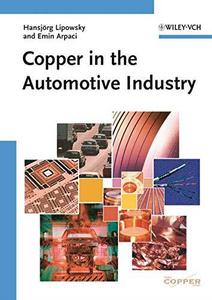 Copper in the Automotive Industry By Dipl.?Ing. (TU) Hansjorg Lipowsky, Dr. Emin Arpaci(auth.) 2007 | 192 Pages | ISBN: 3527317694 | PDF | 2 MB A comprehensive and substantial source of information on the properties, production, processing and applications of copper and copper alloys, of interest to metallurgical, development, design and testing engineers in the automotive and other industries using copper. The authority behind this book - the German Copper Institute - was founded in 1927 and is the technical-scientific advisory center for all questions concerning applications and the processing of copper and copper alloys in Germany. For more than 75 years, the technical scientific advisory and information service of the institute has been providing expert help free of charge. It is supported by the copper industry, the European Copper Institute (ECI) and The International Copper Association. It is competent and active in matters concerning the use of copper not only in automotive but also in all kind of industrial applications, in building construction, in electrical engineering and in questions concerning copper's importance for health.Content: Chapter 1 Raw Material Resources (pages 1-2): Chapter 2 Production (pages 3-9): Chapter 3 Classification of Copper Materials (pages 11-28): Chapter 4 Wrought Copper Materials (pages 29-43): Chapter 5 Copper Casting Materials (pages 45-53): Chapter 6 Properties of the Copper Materials (pages 55-77): Chapter 7 Working with Copper Materials (pages 79-116): Chapter 8 Design Notes (pages 117-121): Chapter 9 Application (pages 123-125): Chapter 10 Usage Properties (pages 127-143): 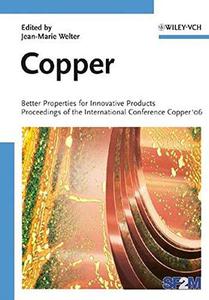 Copper: Better Properties for Innovative Products By 2006 | 332 Pages | ISBN: 3527318844 | PDF | 5 MB Copper was since ever the companion of the development of mankind. Notwithstanding this long history, copper as we know it today is a rather young material. Indeed, the discovery and use of electricity during the 19th century led to a repositioning of copper and opened fantastic opportunities. It started a new career as the metal for generating, transporting and using energy, power and information. This book contains the Proceedings of the International Conference "Copper 06". It gives a broad and up-to-date overview on the recent progress in research and development of copper and copper alloys for usage in modern industrial applications. The current challenges and changes in the international copper industry are also highlighted and the reader gets insight in the driving forces on the international copper market.Content: Chapter 1 Copper on the Move - Where it Comes from, Where it Goes to (pages 1-17): Martin RuhrbergChapter 13 Deformation and Recrystallization Textures and Microstructures in Cold?Drawn Copper (pages 101-107): T. Baudin, A. L. Etter, M. H. Mathon, S. Jakani, P. Gerber, D. Solas and R. Penelle
 Copernicus, Darwin, & Freud: Revolutions in the History and Philosophy of Science By Friedel Weinert(auth.) 2008 | 294 Pages | ISBN: 1405181842 | PDF | 3 MB Using Copernicanism, Darwinism, and Freudianism as examples of scientific traditions, Copernicus, Darwin and Freud takes a philosophical look at these three revolutions in thought to illustrate the connections between science and philosophy. Shows how these revolutions in thought lead to philosophical consequences Provides extended case studies of Copernicanism, Darwinism, and Freudianism Integrates the history of science and the philosophy of science like no other text Covers both the philosophy of natural and social science in one volume Content: Chapter 1 Nicolaus Copernicus: The Loss of Centrality (pages 3-92): Chapter 2 Charles Darwin: The Loss of Rational Design (pages 93-184): Chapter 3 Sigmund Freud: The Loss of Transparency (pages 185-270):  Control of Synchronous Motors By Jean?Paul Louis(auth.) 2011 | 425 Pages | ISBN: 1848212739 | PDF | 10 MB Synchronous motors are indubitably the most effective device to drive industrial production systems and robots with precision and rapidity. Their control law is thus critical for combining at the same time high productivity to reduced energy consummation. As far as possible, the control algorithms must exploit the properties of these actuators. Therefore, this work draws on well adapted models resulting from the Park's transformation, for both the most traditional machines with sinusoidal field distribution and for machines with non-sinusoidal field distribution which are more and more used in industry. Both, conventional control strategies like vector control (either in the synchronous reference frame or in the rotor frame) and advanced control theories like direct control and predictive control are thoroughly presented. In this context, a significant place is reserved to sensorless control which is an important and critical issue in tomorrow's motors.Content: Chapter 1 Synchronous motor controls, Problems and Modeling (pages 1-48): Chapter 2 Optimal Supply and Synchronous Motors Torque Control (pages 49-117): Chapter 3 Optimal Supplies and Synchronous Motors Torque Controls. Design in the d?q Reference Frame (pages 119-172): Chapter 4 Drive Controls with Synchronous Motors (pages 173-220): Chapter 5 Digital Implementation of Vector Control of Synchronous Motors (pages 221-250): Chapter 6 Direct Control of a Permanent Magnet Synchronous Machine (pages 251-281): Chapter 7 Synchronous Machine and Inverter Fault Tolerant Predictive Controls (pages 283-304): Chapter 8 Characterization of Control without a Mechanical Sensor in Permanent Magnet Synchronous Machines (pages 305-346): Chapter 9 Sensorless Control of Permanent Magnet Synchronous Machines: Deterministic Methods, Convergence and Robustness (pages 347-400):
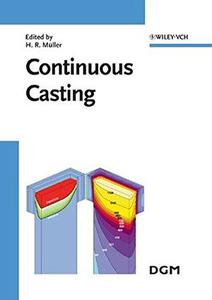 Continuous Casting: Proceedings of the International Conference on Continuous Casting of Non-Ferrous Metals By 2005 | 385 Pages | ISBN: 3527313419 | PDF | 7 MB During the last decade, continuous casting has gained increasing importance as a highly developed technology for the production of superior quality pre-forms for specific subsequent processing by both the copper and the light metals industry. Current progress also includes spray forming as an increasingly important processing option. Therefore, experts from the manufacturing industry, researchers and scientists from university and industry as well as suppliers of equipment and ancillary products need to stay up-to-date on most recent technical, economical and ecological developments. These Proceedings of the Continuous Casting 2005 conference will review the complete range of the processing chain covering both melt treatment and casting technology as well as specific measures for micro-structural control. A focal point of the programme will deal with modelling and simulation that has become an integral part of modern manufacturing. But also safety and health aspects will be approached. 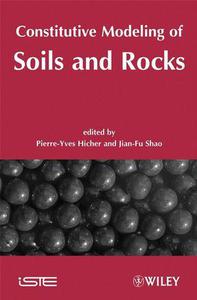 Constitutive Modeling of Soils and Rocks By 2008 | 447 Pages | ISBN: 1848210205 | PDF | 8 MB This title provides a comprehensive overview of elastoplasticity relating to soil and rocks. Following a general outline of the models of behavior and their internal structure, each chapter develops a different area of this subject relating to the author's particular expertise. The first half of the book concentrates on the elastoplasticity of soft soils and rocks, while the second half examines that of hard soils and rocks.Content: Chapter 1 The Main Classes of Constitutive Relations (pages 1-30): Felix DarveChapter 2 Mechanisms of Soil Deformation (pages 31-76): Jean Biarez and Pierre?Yves HicherChapter 3 Elastoplastic Modeling of Soils: Monotonous Loadings (pages 77-142): Philippe Mestat, Emmanuel Bourgeois and Philippe ReiffsteckChapter 4 Elastoplastic Modeling of Soils: Cyclic Loading (pages 143-186): Bernard Cambou and Pierre?Yves HicherChapter 5 Elastoplastic Behavior of Ductile Porous Rocks (pages 187-210): Jian?Fu Shao and Shou?Yi XieChapter 6 Incremental Constitutive Relations for Soils (pages 211-260): Rene Chambon, Felix Darve and Farid LaouafaChapter 7 Viscoplastic Behavior of Soils (pages 261-298): Pierre?Yves Hicher and Isam ShahrourChapter 8 Damage Modeling of Rock Materials (pages 299-346): Andre DragonChapter 9 Multiscale Modeling of Anisotropic Unilateral Damage in Quasi?brittle Geomaterials: Formulation and Numerical Applications (pages 347-376): Djimedo Kondo, Qizhi Zhu, Jian?Fu Shao and Vincent PenseeChapter 10 Poromechanical Behavior of Saturated Cohesive Rocks (pages 377-404): Jian?Fu Shao and Albert GiraudChapter 11 Parameter Identification (pages 405-432): Pierre?Yves Hicher and Jian?Fu Shao  Concise Guide to Hematology By 2011 | 429 Pages | ISBN: 1405196661 | PDF | 20 MB Concise Guide to Hematology is highly practical, user-friendly, and will be invaluable to all residents, fellows, and trainees working with hematology patients. Designed to highlight the important basic concepts and diseases throughout the spectrum of hematology, the book has a clear and accessible format and includes simple line figures, algorithms, and key points thoughout. Each chapter begins with an overview and then main concepts are outlined for each disorder and topic covered. Edited by two leading figures in the rapidly evolving field of hematology, this attractively-produced and concise book is an essential guide and ready resource for all those undertaking rotations and examinations in the discipline.Content: Chapter 1 Introduction to Hematology (pages 1-5): Alvin H. SchmaierChapter 2 Hematopoiesis (pages 6-15): Yuan Lin and Stanton L. GersonChapter 3 Red Blood Cell Biochemistry and Physiology (pages 16-23): Kevin T. McDonaghChapter 4 Anemia: Clinical Approach (pages 24-34): Peter W. MarksChapter 5 Iron Deficiency (pages 35-43): Alice MaChapter 6 Vitamin?B12 (Cobalamin) and Folate Deficiency (pages 44-61): Asok C. AntonyChapter 7 Congenital Hemolytic Anemias (pages 62-74): Archana M. Agarwal and Josef T. PrchalChapter 8 Acquired Hemolytic Anemias (pages 75-90): Scott D. GitlinChapter 9 Overview of Hemostasis (pages 91-102): Alvin H. SchmaierChapter 10 Approach to the Bleeding Patient (pages 103-111): Alvin H. SchmaierChapter 11 Congenital Bleeding Disorders (pages 112-130): Anjali A. Sharathkumar and Steven W. PipeChapter 12 Acquired Bleeding Disorders (pages 131-139): Howard A. LiebmanChapter 13 Platelet Function in Hemostasis and Inherited Disorders of Platelet Number and Function (pages 140-153): A. Koneti Rao and David W. EssexChapter 14 Acquired Thrombocytopenia (pages 154-173): Theodore E. Warkentin and Andrew E. WarkentinChapter 15 Thrombosis and Anticoagulation (pages 174-183): Alvin H. SchmaierChapter 16 Myeloid Cell Physiology and Disorders (pages 184-196): Alvin H. Schmaier, Lilli M. Petruzzelli, Niels Borregaard and Laurence A. BoxerChapter 17 Bone Marrow Structure and Diagnostic Testing (pages 197-219): Howard J. Meyerson and Hillard M. LazarusChapter 18 Myeloproliferative Neoplasms and Myelodysplastic Syndromes (pages 220-234): Gabriela Motyckova and Richard M. StoneChapter 19 Acute Leukemia (pages 235-250): Tsila Zuckerman and Jacob M. RoweChapter 20 Classifi cation of Lymphoma (pages 251-267): Yi?Hua Chen and Amy ChadburnChapter 21 Clinical Evaluation and Management of Lymphoma (pages 268-286): Makiko Ban?Hoefen, Jonathan W. Friedberg and Richard I. FisherChapter 22 Plasma Cell Disorders (pages 287-306): Sumit Madan and Philip R. GreippChapter 23 Pediatric Hematology (pages 307-318): Sanjay P. AhujaChapter 24 Blood Banking (pages 319-331): Lawrence Tim GoodnoughChapter 25 Transfusion Therapy (pages 332-343): Beth H. Shaz and Christopher D. HillyerChapter 26 Hematopoietic Cell Transplantation (pages 344-362): Hillard M. LazarusChapter 27 Atlas of Hematology Slides (pages 363-387): Alvin H. Schmaier 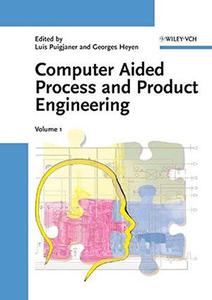 Computer Aided Process and Product Engineering By 2006 | 889 Pages | ISBN: 3527308040 | PDF | 51 MB Computer aided process engineering (CAPE) tools have been very successfully used in process design and product engineering for a long time. In particular, simulation and modelling tools have enabled engineers to analyse and understand the behaviour of selected processes prior to building actual plants. The aim of design or retrofit of chemical processes is to produce profitably products that satisfy the societal needs, ensuring safe and reliable operation of each process, as well as minimising any effects on the environment. This involves the conceptual design or retrofit of plants and processes, novel manufacturing approaches, process/control system design interactions and operability, manufacturability, environmental and safety issues. Backed by current studies, this 2-volume set gives a comprehensive survey of the various approaches and latest developments on the use of CAPE in the process industry. An invaluable reference to the scientific and industrial community in the field of computer aided process and product engineering.Content: Chapter 1 Introduction (pages 1-10): Luis Puigjaner and Georges HeyenChapter 1 Large?Scale Algebraic Systems (pages 15-34): Guido Buzzi?Ferraris and Davide MancaChapter 2 Distributed Dynamic Models and Computational Fluid Dynamics (pages 35-106): Young?Il Lim and Stem Bay JorgensenChapter 3 Molecular Modeling for Physical Property Prediction (pages 107-135): Vincent Gerbaud and Xavier JouliaChapter 4 Modeling Frameworks of Complex Separation Systems (pages 137-169): Michael C. Georgiadis, Eustathios S. Kikkinides and Margaritis KostoglouChapter 5 Model Tuning, Discrimination, and Verification (pages 171-187): Katalin M. Hangos and Rozalia LaknerChapter 6 Multiscale Process Modeling (pages 189-221): Ian T. Cameron, Gordon D. Ingram and Katalin M. HangosChapter 7 Towards Understanding the Role and Function of Regulatory Networks in Microorganisms (pages 223-264): Krist V. Gernaey, Morten Lind and Sten Bay JorgensenChapter 1 Synthesis of Separation Processes (pages 269-296): Petros Proios, Michael C. Georgiadis and Efstratios N. PistikopoulosChapter 2 Process Intensification (pages 297-326): Patrick Linke, Antonis Kokossis and Alberto Alva?ArgaezChapter 3 Computer?Aided Integration of Utility Systems (pages 327-381): Francois Marechal and Boris KalitventzeffChapter 4 Equipment and Process Design (pages 383-418): I. David, L. Bogle and B. Eric YdstieChapter 5 Product Development (pages 419-442): Andrzej KraslawskiChapter 1 Resource Planning (pages 447-479): Michael C. Georgiadis and Panagiotis TsiakisChapter 2 Production Scheduling (pages 481-516): Nilay ShahChapter 3 Process Monitoring and Data Reconciliation (pages 517-540): Georges Heyen and Boris KalitventzeffChapter 4 Model?Based Control (pages 541-576): Sebastian Engell, Gregor Femholz, Weihua Gao and Abdelaziz ToumiChapter 5 Real Time Optimization (pages 577-590): Vivek Dua, John D. Perkins and Efstratios N. PistikopoulosChapter 6 Batch and Hybrid Processes (pages 591-619): Luis Puigjaner and Javier RomeroChapter 7 Supply Chain Management and Optimization (pages 621-641): Lazaros G. PapageorgiouChapter 1 Integrated Chemical Product?Process Design: CAPE Perspectives (pages 647-666): Rafiqul GaniChapter 2 Modeling in the Process Life Cycle (pages 667-693): Ian T. Cameron and Robert B. NewellChapter 3 Integration in Supply Chain Management (pages 695-730): Luis Puigjaner and Antonio EspunaChapter 4 Databases in the Field of Thermophysical Properties in Chemical Engineering (pages 731-745): Richard SassChapter 5 Emergent Standards (pages 747-768): Jean?Pierre Belaud and Bertrand BraunschweigChapter 1 Integrated Computer?Aided Methods and Tools as Educational Modules (pages 773-798): Rafiqul Gani and Jens AbildskovChapter 2 Data Validation: a Technology for Intelligent Manufacturing (pages 799-826): Boris Kalitventzeff, Georges Heyen and Miguel MateusChapter 3 Facing Uncertainty in Demand by Cost?Effective Manufacturing Flexibility (pages 827-851): Petra Heijnen and Johan Grievink 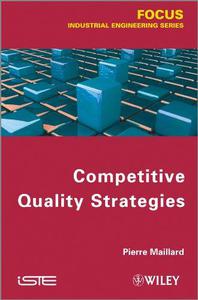 Competitive Quality Strategies By Pierre Maillard(auth.) 2012 | 165 Pages | ISBN: 1848214510 | PDF | 4 MB This book succinctly presents new methodological principles that will help you raise the quality of your valuable production to enhance your competitiveness. The concepts and models of principles of actions presented result from over 20 years of the author observing the ways in which companies of all sizes and in all sectors use specific mechanisms of quality production to give rise to long-lasting competitive factors. You'll find practical guides that will help you better understand and strengthen your approaches to create new competitive edges, based on your employees' culture of quality.Content: Chapter 1 General Principles of Competitive Quality (pages 1-16): Pierre MaillardChapter 2 The Definition of a Competitive Quality Tactic (pages 17-50): Pierre MaillardChapter 3 Deployment of a Competitive Quality Tactic (pages 51-84): Pierre MaillardChapter 4 The Conditions for Success of a Competitive Quality Tactic (pages 85-100): Pierre MaillardChapter 5 Selling a Competitive Quality Tactic (pages 101-116): Pierre MaillardChapter 6 Management of a Competitive Quality Tactic (pages 117-150): Pierre Maillard |